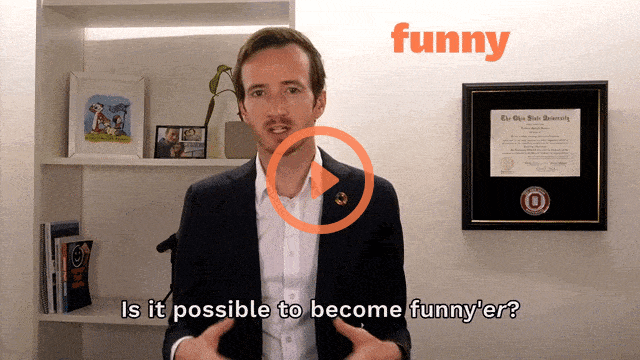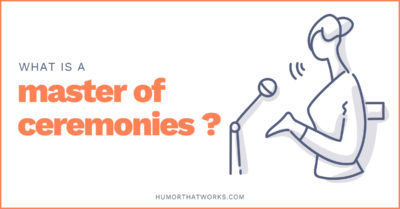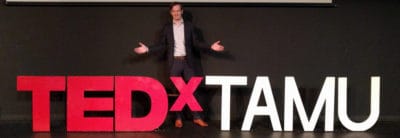Now that you know the benefits of creating an employee awards program, you may be wondering how you go about actually doing it. Luckily I’ve created and hosted my fair share of events (including the recent Corporate Humor Awards) and I’ve got all the steps you need to have a successful awards show.
8 Steps to Creating a Great Employee Awards Program
Here’s how to show your employee appreciation in just 8 steps:
1. Decide on Your Award Categories
First, you’ll need to decide on what exactly you’ll be recognizing through your awards. The categories should cover areas that you want to recognize but also want other employees to focus on. It’s also worth including a few fun employee award categories to keep the awards ceremony interesting.
In the case of the Corporate Humor Awards, we picked categories that could show how humor can be effectively implemented in the largest number of organizations or for the largest number of individuals.
We chose to recognize both individuals and organizations. At an individual level, we recognized: Best Email, Best Presentation, Best Video, Best Story, Best Prank, and Best Humorist. At the organizational level, we recognized: Best Onboarding, Best Training, Best Best Website, Best Perk, Best Recognition, and Best Corporate Culture.
We also included “custom award categories” that allowed nominators to customize the awards program.
2. Collect Nominations
Next you’ll collect nominations for each of the award categories you chose in Step #1. The easiest way to do this is via a form submission, such as what you can create with Google Forms (which was used for the humor awards) or Survey Monkey. You can also accept these nominations via email but the collection process will be more manual.
When collecting nominations, be sure to collect the nominee’s name, reason for submission, and nominator’s name (or nickname if you want nominations to remain anonymous).
I also like to use the nomination form as a time to ask a fun/interesting question of the nominator as well, just to get a sense of the people submitting nominations. Examples of questions I’ve used in the past include:
- What is your favorite color?
- What is one thing everyone should do in New York City?
- What song are you listening to right now?
3. Determine Finalists
Once you have the nominations, you’ll need to narrow down to a set of a finalists. For smaller organizations, you may decide that all nominations are finalists; for larger organizations you may want to narrow it down to 3 to 5 potential winners.
There are a number of strategies you can use to narrow down your nominations:
- Have One Person Pick. The quickest way of selecting finalists is to just have one person pick them. It could be the person running the event or perhaps the senior most person in the organization (this is what we did for the Corporate Humor Awards).
- Create a Panel. If you want the process to be more democratic, you can put together a panel of judges from people on the planning committee or in the organization who then choose their top choices. Keep the panel to an odd number of people when possible to help prevent ties.
- Apply a Rubric. If you want to make the process as objective as possible, you can create a rubric for selecting finalists that is applied across all nominations.
- Choose Randomly. If you have far too many nominations to narrow down, you could choose 5 finalists randomly from the nominated.
No matter which way you choose, you may want to inform the nominators / nominees of what process was used so there isn’t any confusion.
4. Announce the Finalists (Optional)
Regardless of how you do it, narrowing the list down to finalists can be a great way of creating buzz about the awards by announcing the finalists before announcing the winners.
This can be done privately to each of the finalists so they can get excited for when the winners are selected, or even more fun, an announcement to the entire organization so there is a buzz when the winners are announced.
Monthly newsletters, corporate memos, and breakroom TVs are great places to lists the finalists prior to the awards ceremony.
5. Pick the Winners
When you have your finalists, it’s time to choose the winners. Just as when selecting the finalists, you have the same four ways you can choose the winners: have one person pick, create a panel, apply a rubric, or choose randomly.
Personally I think it’s best for winners to be selected by a panel. This helps ensure that bias is removed from the equation but also that the best nomination win (as opposed to being randomly selected). An easy way to do this is to have each member of a panel rank their top 3 choices. Then take the average of all judges responses and the finalists with the best average score is the employee award winner.
I also recommend having judges share 1 or 2 sentences about why they chose their top response. This gives you a great soundbite / blurb to share when announcing who won. For example, Mary Kay had this to say about Best Onboarding Winner, Intel:
“What an amazing way to introduce new employees to everyone else. Energizing for both new folks and current employees.” –Mary Kay Morrison
6. Announce the Winners
Once you have the winners, it’s time to announce them to the organization! You can do this either digitally (such as through email, newsletter, or press release) or at an event (such as a corporate offsite or quarterly meeting).
An in-person event is more ideal as it increases the exposure of the winners and finalists, and adds an element of prestige to awards. However, if this isn’t possible, a digital announcement can still be an impactful way showing your employee appreciation.
A natural place to share the employee award winners is with your other forms of rewards and recognition, such as when announcing work anniversaries, promotions, or retirements.
7. Award the Winners
After you’ve announced the winners, it’s time to “tell them what they’ve won” (although you may actually want to say what the winner will receive long before the announcement as a way of drumming out excitement). But now is when you’ll actually give the award to the employee.
The award itself doesn’t have to be anything fancy. It can be as simple as an employee award certificate with their name and award category that they won, or it can also come with a gift such as a gift certificate, extra vacation day, or cowbell.
The Corporate Humor Award winners received a digital certificate and a copy of my book, Humor That Works: 501 Ways to Use Humor to Beat Stress, Increase Productivity, and Have Fun at Work.
8. Spread the Word
Finally, once you’ve given out the employee awards, it’s time to spread the word about the great work the winners did. This allows you to further leverage the employee awards program by getting it out to more people so they too can be inspired.
Employee Awards Program Kit
Ready to create your own employee awards program? Download the completely free Employee Awards Program Kit and start recognizing your employees today.



